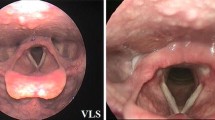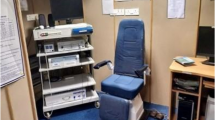Abstract
Benign disease of larynx frequently present with voice disorder. Observing the larynx with high resolution stroboscope and its mucosal wave pattern with greater precision aids in the better understanding of normal/abnormal anatomy and function, which forms the basis of designing treatment strategies.Videolaryngostroboscopy now a days is considered routinely used method of vocal fold examination and evaluation of patients with voice disorders. This valuable imaging tool can also be used to assess the outcomes of therapy of laryngeal diseases or functional result of phonosurgical procedures. Present study, videostroboscopic assessment of 81 cases of different benign vocal cord pathologies was done. Stroboscopic parameters like glottic closure, amplitude, vocal fold edge, symmetry, periodicity and mucosal wave pattern were studied and statistically significant relationship with different vocal pathologies were obtained.



Similar content being viewed by others
References
Garcia M (1885) Observations on the human voice. Proc R Soc Lond 7:397–410
Shaw H (1955) Manuel Garcia—a centenary tribute. J LaryngolOtol 69:342–346
Oertel M (1895) Das laryngo-stroboskop und die Laryngo-StroboskpischeUntersuchung. Arch Laryngol Rhinol 3:1–16
Hirano M (1981) Clinical examination of voice. Springer, New York
Bless DM, Hirano M (1987) Feder RJ Videostroboscopic evaluationof the larynx. Ear Nose Throat J 66(7):289–296
Silverman E-M (1975) Zimmer CH Incidence of chronichoarseness among school-age children. J Speech Hear Disord 40:211–215
Lacina O (1972) The incidence of vocal fold nodules with singers[Das Vorkommen von Stimmlippenkno¨tchenbei den Sa¨ngern]. Folia Phoniatrica 24:345–354
Urrutikoetxea A, Ispizua A (1995) Matellanes F Pathologie vocals chez les professeurs: un etude video-laryngo-troboscopiquede 1046 professeurs. Rev LaryngolOtolRhinol 116:255–262
Nagata K, Kurita S, Yasumoto S et al (1983) Vocal fold polyps and nodules. A 10 year review of 1156 patients. AurisNasusLarynx 10(Supll):S27–S35
Kleinsasser O (1991) Restoration of the voice in benign lesions ofthe vocal folds by endolaryngeal microsurgery. J Voice 5:257–263
Dobres R, Lee L (1990) StempleJ, Kummer A, Kretchmer L Description of laryngeal pathologies in children evaluated by otolaryngologists. J Speech Hear Disord 55:526–533
Banjara H, Singh D (2012) Demographic andVideostroboscopicAssesment of vocal Pathologies. Indian J Otolaryngology Head Neck Surg. 64(2):150–157
Sercarz JA, Berke GS, Arnstein D, Gerratt B, Natividad M (1991) A new technique for quantitative measurement of laryngeal videostroboscopic images. Arch Otolaryngol Head Neck Surg 117:871–875
Estes C, Sadoughi B, Mauer E, Christos P, Sulical L (2012) Laryngoscopic and stroboscopic signs in the diagnosis of vocal cord parasis. The Laryngoscope 127(9):2100–2105
Quirba AS, Darweesh ME (2015) Voice changes and laryngo-video-stroboscopic findings in pateints with vocal fold polyps and cysts. Egypt J Otolaryngol [series online] 31:47–53
Sataloff RT, Spiegel JR, Hawkshaw MJ (1991) Strobovideolaryngoscopy: results and clinical value. Ann Otol Rhinol Laryngol 100(9):725–727
Shohet JA, Courey MS, Scott MA, Ossoff RH (1996) Value of videostroboscopic parameters in differentiating true vocal foldcysts from polyps. Laryngoscope 106:19–26
Funding
No funds received No financial aid have been received for conduction of this study which is a clinical study done with available resources.
Author information
Authors and Affiliations
Corresponding author
Ethics declarations
Conflict of interest
compliance with ethical standard was done Ethical clearance was obtained from institutional ethical committee. No conflict of interest is there in between author 1and Author 2. And author 3.
Additional information
Publisher's Note
Springer Nature remains neutral with regard to jurisdictional claims in published maps and institutional affiliations.
Rights and permissions
About this article
Cite this article
Sachdeva, K., Mittal, N. & Sachdeva, N. Role of Video Laryngostroboscopy in Benign Disease of Larynx. Indian J Otolaryngol Head Neck Surg 72, 267–273 (2020). https://doi.org/10.1007/s12070-020-01827-8
Received:
Accepted:
Published:
Issue Date:
DOI: https://doi.org/10.1007/s12070-020-01827-8




